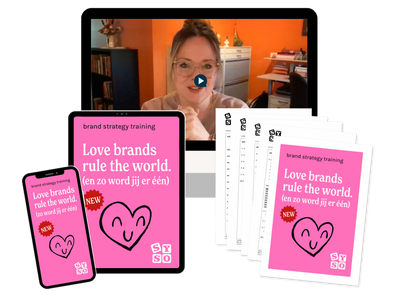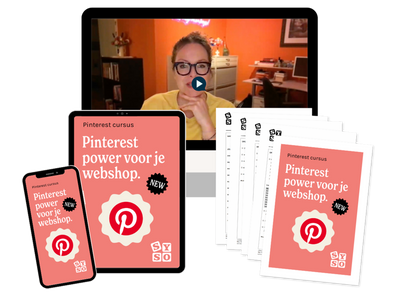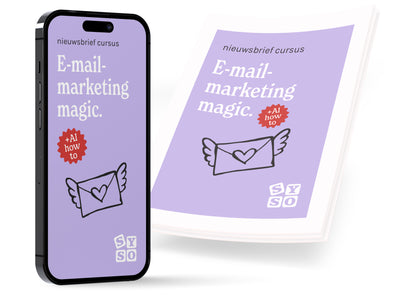For many online store owners, SEO or the art of being found in Google's organic search results is and remains the most important channel to attract visitors. A web store that is not shown on the first page for relevant searches can be compared to a clothing store on a deserted industrial estate.
But landing on the first page of Google search results is easier said than done. According to SEO specialists, Google would already consider more than 200 factors to base the rankings on. Then there are also tools online that perform an 'SEO check' of your website and then come up with a laundry list of recommendations. Quite overwhelming if you are just getting started with SEO. In this article I want to take you by the hand to take the most important starting steps to get things on track.
Google Search Console: Swiss Army Knife for Organic Findability
Well, you've captured a catchy company name and associated domain name, placed with a reliable host. You have opted for a CMS like Woocommerce (WordPress) or a Saas solution like Shopify . You have already filled the shop with some texts and products. But what now?
In the first place, I would directly recommend that you install Google Search Console as soon as possible. This is a program from Google itself. Completely free to use and without obligation. Because Google Search Console in principle does not record data such as IP addresses and personal data, you do not have to worry about privacy 'hassle' such as the AVG. Google Search Console only starts collecting useful data after you install it, so I recommend doing this as soon as possible.
Google Search Console unlike Google Analytics is compact and well-arranged. You certainly don't have to follow a course to be able to use it. You can see Search Console as a conduit between Google and yourself regarding the organic performance of your webshop. If there is something wrong with your web store, for example you may have accidentally turned on a function within your web store system that makes an important page or section of your website inaccessible to the search engine, you will hear about this here and nowhere else.
Google Search Console favorite reports top 3
I'll be sharing a top three of my favorite Search Console reports that I believe are most helpful to novice online merchants.
1 - Achievements
Unfortunately, Google has started to shield more and more keyword data within Google Analytics and also within Google Ads for non-paying customers. But in the performance report of Search Console you will find a lot of data free of charge and without obligation, which terms your ideal customer uses.
 Google Search Console | Homemade screenshot | 27-03-2020
Google Search Console | Homemade screenshot | 27-03-2020
You can see which terms are most searched for by your target group by sorting by impressions.
A useful exercise can also be to see where you have a high average position, by sorting by position and comparing this to the click-through rate (CTR). If you are on average in the top 3 in the ranking, but the click-through percentage is relatively low, then the presentation of the search result of the relevant page may not be attractive enough. We also call this the meta data of a page. How do you create meta data that encourages clicks?
I came across this search result below in practice. This is not a customer of the undersigned, but I fell (positively) on this presentation:
 Google.nl | Homemade screenshot | 27-03-2020
Google.nl | Homemade screenshot | 27-03-2020
I can't look at this lot in the Search Console data, but I do have a dark suspicion that this presentation provides an improved click-through. They are therefore at the top of Google for many keywords. I feel a tendency to click thanks to this presentation, even if I am not looking for window decoration myself, it is that convincing. I've implemented this style for some of my own websites, and I've seen a slight increase in CTR. The green background checks, love it or hate it. Some of my clients find it disfigured, and I kind of agree. But it does catch attention among the other monotonous-looking search results.
Other things that make this a successful meta description in my humble opinion are the short catchy text fragments. Free certainly scores very well in the Netherlands. If you can give something away for free, a gift for customers or the shipping costs, then you should definitely mention this in the meta data.
But where do you find the meta data?
In most web store systems, you can simply find it on the appropriate page within the web store system. The name for the section may vary, but will denote something like search engine presentation, title (tag), meta description. There you can enter this data.

Sellyourstuffonline.nl | Screenshot of the meta data of this blog post | 20-04-2020
To return to the Search Console presentation report. Another useful exercise can be to download the data to spreadsheet software such as Excel. You can also apply filters. For example, what I like to do is sort by impressions and then put a filter on average position (above 10). This way you can immediately see where so-called low-hanging fruit options are available for your online store. In other words, there is a lot of interest from your target group, but your webshop is not (yet) present on the first page for this theme.
2 - URL Inspection
Previously, you created a page on your website, and then you had to wait weeks before Google finally found the new page and included it in its search results index. That is no longer the case. Through Search Console you can directly request indexation from Google. My practical experience is that the new page will be live in the index within moments.
3 - Coverage
Here you will find an overview of (hopefully not natural) problems that Google has with processing your website in the search results. Quite often there is also a false alarm here, in that case you can click on 'validate solution'. But if it is a serious problem or if you have any doubts about it, you can of course always contact the support of your web store software provider.
Category and Brand Pages
You now have Search Console active on your web store and have become familiar with the most important reports for presentation in the organic search results and technical issues. But at the end of the day, it's all about the content. Even though there are more than 200 ranking factors as already mentioned in the introduction of this article, according to Google itself ( source ) the content belongs to the top 3 of most important points of interest. But what is the most important content of an online store?
The backbone for almost every webshop in terms of SEO performance are category and brand pages. The homepage is often too general. And individual product pages too specific. Google prefers to land the searcher on a so-called category page for terms such as dresses, wooden blinds or headphones. After all, Google cannot yet determine from the search what kind of dress the searcher wants exactly. Specifications such as which color, which length and so on are missing. These types of searches often have the most volume, so you definitely don't want to miss out.
What is really important for a category page?
First of all, wide range of products. Many options to choose from. In the case of dresses, you naturally want to see many colors and different styles, for example.
From a SEO point of view, however, a page that merely provides an overview of products does not have much unique added value for search engines. Ideally, you want to provide some informative unique content in addition to the product display. However, you want to do this in a way that does not come at the expense of conversion.
Beginner mistake
A beginner's mistake some online merchants make is to start with a wall of text at the top of the page. Although it is true that Google places more weight on content that is visible immediately upon landing on the page (above the fold we call this in jargon), this is obviously not good for visitors, they will be deterred. A large number of them will then click directly on the browser's 'back button', which of course is not good, both in terms of conversion and SEO.
I think the ideal setup is a sandwich approach. Start with a little bit of introductory text, maybe 2 - 4 lines. Then the products display. Below the products view can be placed an extensive help guide, an informative piece of content that tells searchers more about the (main) products in the category in question, information about how to determine the size, and so on.
Here are some practical examples of webshops that I think approach this in the right way:
- https://www.ikwilzitzaks.nl/kinder-zitzaks (custom webshop system)
- https://www.123paracord.nl/paracord-550-type-iii/ (Lightspeed)
- https://www.fastfuriousscooters.nl/vespa/custom/ (Shoptrader)
- https://www.hemdvoorhem.nl/ijzergratis-overhemden (custom webshop system)
In a nutshell, you want to start with a brief piece of text, as an introduction. Then shortly afterwards images, showing the products that the searcher is interested in, as soon as possible. The product filter navigation is generally on the left. Below the products display helpful and/or inspiring content. Ideally, it should be written by a person with many years of practical experience with the products in question. If you find a blank Word, or whatever word processor you use, screen intimidating, you can also consider hiring a freelance copywriter through a platform like Upwork and provide them with instructions. After receiving the text, you, as an expert within your business, can lift the text to a higher platform. Ideally, all important category pages should be provided with thorough text.
How many words then?
I would aim for at least 200 words of text in total. But it depends on the subject. You simply cannot write about some topics without repeating yourself or producing nonsensical text. So more is definitely not better. And process search terms? I have read somewhere that a keyword must be mentioned 5 times in the text, preferably once in bold and once in italics? Unfortunately, there are still many myths about SEO writing. I can disprove that things like forcing keywords, making them bold or italicized have any value for performance in search results ( source ). If this helps for clarity or readability of the text in question, that's fine of course. But if you do it purely for SEO gain, then this seems like a bad idea to me.
Keep texts as natural as possible
Forcibly dropping keywords in the text does not look good to readers (real people), and can make them drop out, which can indirectly have a negative impact on the ranking of your webshop, because Google includes user signals in its algorithm. You're really just shooting yourself in the foot with that. So try to keep the texts as natural as possible, don't think too much about SEO.
The same applies to brand pages, so overviews of the products of a certain brand offered in your webshop. For example, if you have an online fruit store, this is an overview of only Chiquita bananas and no other banana brands. In principle, a brand page is also just a category page, only then categorized by the relevant brand.
Do products need a unique text?
And what about products? Do they all have to be provided with a unique text? It depends. If it is a manageable number of products then I would recommend this. When it comes to hundreds if not thousands of different products, this is probably not feasible in terms of time and budget. In that case you could only write texts for the most important, perhaps iconic or flagship products. In any case, search volume is lower at this level.
In my opinion, the most important content pages for a webshop are usually the category and/or brand pages. I would not recommend blogging for the sake of blogging for an online store. However, functional blogging does. But if there are search terms that are purely informative in nature, it is conceivable that the searcher may be interested in the products you offer at a later stage. Consider, for example, a search query such as 'how to make a friendship bracelet' for a jewelry web store that sells the individual parts needed to make such a bracelet. In such a case it can be very interesting to write a blog tutorial, and a blog is a much better tool for that than a category page.
👉 With the Content coach program you learn to use the blog functionally, also for the benefit of a good SEO!
A flat website structure
It is important that the most important category and brand pages are as accessible as possible for both the visitor and Google. You also want to mention this in the menu of the webshop. Preferably the top menu. However, you don't want to overfill this menu, think of the concept ' the paradox of choice '. You can link to slightly less important categories in some web store systems from the footer, i.e. the bottom of the web store. SEO specialists generally prefer a flat website structure. What we mean by this is that it is possible for both visitors and Google to reach a category, brand or product page within a maximum of 2 – 3 clicks. You want to have the most crucial pages for sales within 1 click from the homepage, so for example by means of inclusion in the main menu. You leave less important pages outside the menu, but you can link to them from the text of pages that are in the menu. To create an overview for yourself, I would recommend making a so-called mind map before you start setting up the webshop structure.
well on the way
Periodically reviewing important Search Console reports such as performance can help you fine-tune your course. By continuing to add new category pages with enough unique content according to keyword research within a structure that makes logic for both visitors and search engines, you can continue to grow your online store without incurring significant costs.
About the author
Romano Groenewoud works as a freelance SEO specialist for freelancers and SMEs in the Netherlands. His nickname is ' SEO Geek' . Here's what he is: Romano lives, eats, drinks, sleeps and breathes search engine optimization. His main drive is to achieve top positions in Google's organic search results. Nothing gives him a greater kick than trumping large corporations for competitive keywords. He also conducts these campaigns, together with a team of freelancers, wholly independently of a location as a digital nomad from tropical regions ranging from the Philippines to Peru.










